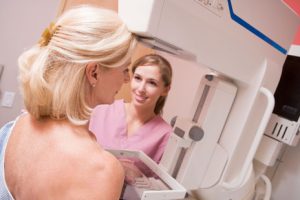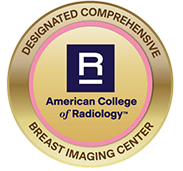3D Mammography
Early Detection Saves Lives.
We were the first facility in Westchester to be designated a Breast Imaging Center of Excellence by the American College of Radiology. As described by the ACR, the designation is awarded for “achieving excellence by seeking and earning accreditation in all of the ACR’s voluntary breast imaging programs and modules”. At Rye Radiology be confident with the most advanced mammographic exam in the industry. Rye Radiology was the first facility in the greater Westchester County area to offer the breakthrough, FDA-approved 3D mammography machine, also known as breast tomosynthesis. 3D digital imaging only takes 10 seconds and finds 40% more invasive breast cancers than traditional 2D mammography alone (with fewer false positives) using about the same amount of x-ray exposure as a traditional mammogram.*
3D digital mammograms, a groundbreaking technology, take exceptionally sharp, thin section digital images of the breast at three different angles – up and down, left to right and layer-by-layer – providing our doctors with highly detailed information.
The 3 dimensional image set means that it is more difficult for cancer to hide behind overlapping tissue and less chance our doctors will need a second look, meaning less x-ray exposure overall.
One in eight women will develop breast cancer sometime in her life. The stage at which breast cancer is detected directly influences a woman’s survival. An annual mamogram is one of your best defenses against breast cancer. Research has shown that despite its ability to reduce breast cancer mortality, screening mammography is an imperfect tool that can miss breast cancer in some women, particularly those with dense breasts. Recent studies have shown that screening breast ultrasound is capable of detecting some cancers that are undetected by mammography and physical examination. Screening ultrasound should only be contemplated as a supplement to and not a replacement for mammography. If your doctor has told you that you have dense breasts, a screening ultrasound may be ordered to supplement the mammography,
On the day of your exam do not wear any powder or deodorant. If this is your first mammography with us, if possible, please bring your prior mammograms to the appointment. We schedule mammography exams 7 – 10 days from the first day of your menstrual cycle. Please call us the first day of your cycle and we will be happy to schedule your exam. If you have a concern or need an appointment immediately we will accommodate you.
Your results will be provided on the day of your exam.
What Can You Do?
Rye Radiology recommends following these guidelines:
- Have a baseline mammogram at the age of 35, then every 1 – 2 years depending on your risk factors until the age of 40. Very high risk patients (genetically positive for BRCA I or II gene or mother or sister with premenopausal breast cancer) may need earlier and more frequent screening.
- If you are between the ages of 40-49, have a mammogram every year. Research has shown that there is more rapid growth of cancer cells in this age group.
- If you are over the age of 50, have a mammogram yearly.
- Perform a breast self-exam monthly.
- Have your doctor perform a breast exam.
- Patients with dense breasts will benefit from breast ultrasound in addition to mammography.
- High-risk patients may also benefit from MRI of the breast.
See Your Doctor If:
- You find a lump
- You develop a nipple discharge
- You notice any other change in your breast
How To Prepare For Your Mammogram:
If your breasts are tender you may take 200 mg of Motrin/Ibuprofen eight hours before and then again one hour before your scheduled exam. (If you have a history of aspirin or Motrin allergy, do not take any medication).
Online Breast Cancer Risk Tools:
Harvard Center for Cancer Prevention – http://www.diseaseriskindex.harvard.edu/update/
National Cancer Institute- http://www.cancer.gov/bcrisktool
Tomosynthesis is one more tool to make early detection even earlier. Watch our video to learn about how 3D Digital Mammography can help in the detection of breast cancers.

